New York City has 5.2 million trees, and each one of them has a life story. For a very long time, a lovely European larch has marked the seasons for those walking in Central Park. It is a deciduous conifer whose needle-like leaves turn yellow in the autumn and fall off. A tulip tree in Staten Island’s Clove Lakes Park, dubbed “The Clove Lakes Colossus,” is renowned for its massive trunk with a circumference of 21.4 feet. It’s reportedly 300 years old. The ginkgo trees on Manhattan’s Restaurant Row, planted as part of a spruce-up project along West 46th Street a couple of decades ago, cheer city folk and tourist alike with blossoms heralding the spring. New Yorkers, to be sure, get to know their trees very well and love them.
So what is it with the tree on Greenwich Street that is connected to a chain-link fence? What is its life story? I can’t help but wonder this when I look at this sturdy, lonesome tree along the stretch of Greenwich Street between West 10th and Charles streets, in Manhattan’s West Village. Someone has actually linked it up to the chain-link gated fence to a driveway just south of 705 Greenwich St. The sight of this tree pretty much stops me in my tracks, as I’m not sure I’ve ever seen anything like it – a tree so interconnected with a manmade object.
The sight sets the mind to wondering and considering questions. In essence, a tree connected to a chain-link fence is a mystery. It personifies New York in some ways, especially the closest of close encounters between humans and nature that occur here. Who planted the tree, and how long ago? When did its existence become married to chain link? What was the circumstance of the fence’s establishment? Who did this, and why? How is the tree adapting? It all feels like a mystery I want to solve.
The Demand for Space
The tree is not grand, yet it inspires admiration. It’s the kind of quirky feature that has become part of New York’s landscape. It’s a metaphor of mankind’s intrusion into the natural world. The tree is akin to a small building one sometimes sees where the owner resolves to stay despite newer buildings that others are constructing in its midst, the holdout in an inhospitable place. I look at the tree’s creases from the fence and marvel. The impressions of the fence in the trunk give a sense that the tree is not giving way. To be with the tree, as Buddhist monk and author Thich Nhat Hanh might say, is to feel it has pain and strength.
At the same time, the tree brings to mind New Yorkers. For a person to endure in a city of 8 million people, he or she must be quite hardy and adaptable. The city constantly demands such qualities. To live in New York is to live with encroachment for the life it offers. This tree certainly has been encroached upon, and it shows it. Yet it survives and adapts, providing a respite of nature, help in the effort to slow global climate change, and gifts such as shade in the summer.
Could whoever put up the driveway gate have found a better way in order to respect the tree? Yes, surely. Somehow, however, the tree appears to be seeking to hold its own and to somehow grow. On an April day, it stopped this passer-by, and I became invested in its life story.
Next post: Looking at the tree sparks a close-up appreciation of details on this block of Greenwich Street.
The tree trunk
The tree’s base
The post and tree
Deep grooves where the tree grew against the fencing
Metal jutting into the tree
A view, from across the street, of the full tree with the chain-link gate

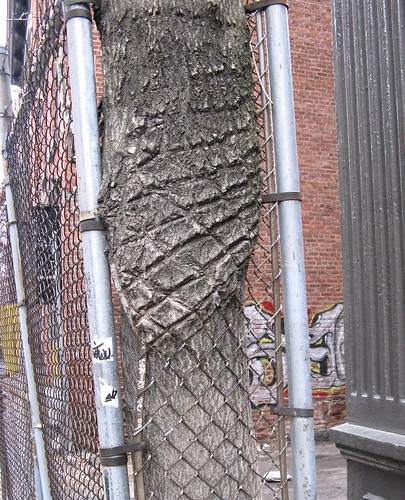
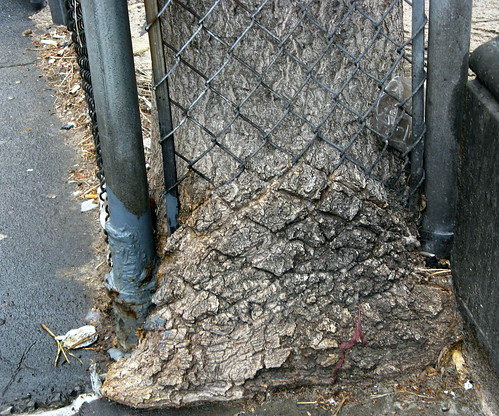
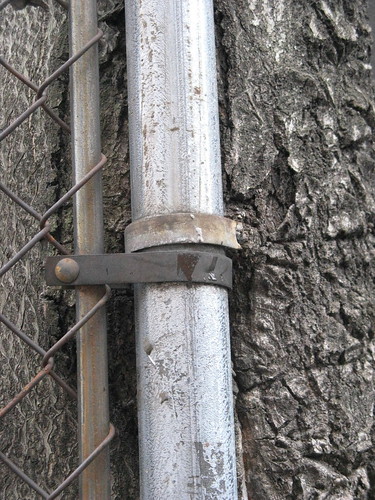
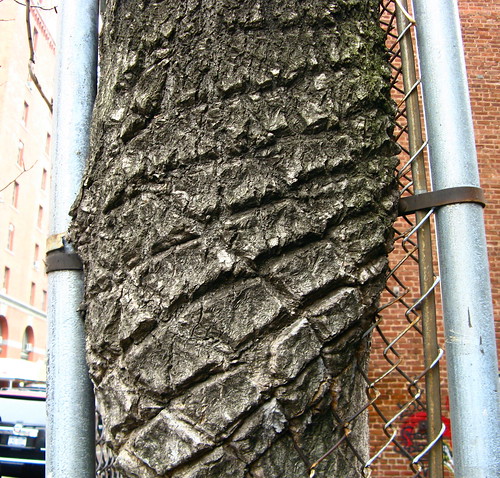
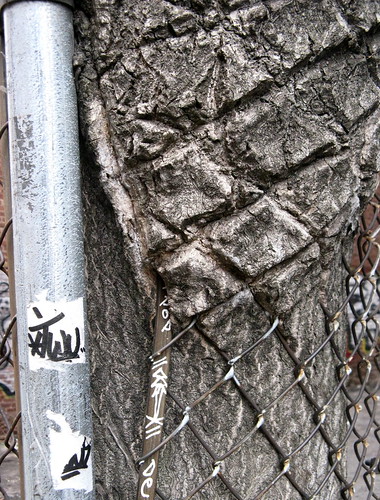
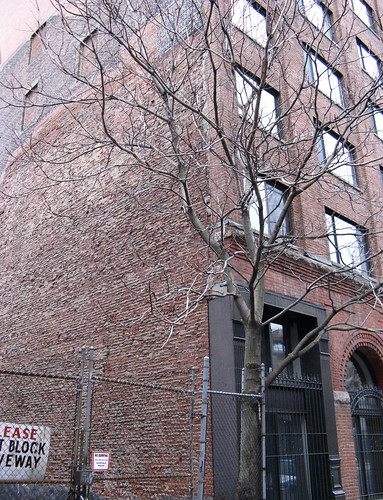



Great photos, Susan. This is now one of my favourite things about New York and when/if I get back there I hope to be able to see it for myself.
There are some trees near my house in Port Melbourne that stand along the boundary of a former railyard that is now open space , and they too have grown around the poles of the now long-removed fence.
I think it shows that whatever we do to the planet, nature will adapt and some life will survive. It probably won’t be us, but then we’ve got no-one to blame but ourselves.
Wonderful comments, David. Thanks! When/if I get to Melbourne, I’ll have to see those trees at the boundary of the former railyard.
Like you, I thought a lot about the messages of this tree in terms of our planet. Amazing how one individual unit of nature can show us these lessons…if we are ready to learn them and adapt ourselves!
All the best,
Susan
What an inspiring post on the power of resilience!
Thanks, Ginny, and happy that you found it so. That resilience is probably a major reason why I liked communing with this tree!
Enjoy your day,
Susan
Wow, Susan. That is just amazing to see the cross-hatched scars in the bark from the fence. The tree resembles elephant flesh, and the scars …
Thanks to you for being such a keen-eyed walker. It’s so easy to see but not SEE, isn’t it?
Melissa,
You’re right — it is like elephant flesh. I know…I find myself staring more and more at those cross-hatched scars. Hard to believe. The one photo especially seems to say to me, “Tree vs. Fence. Tree Winning.”
I’m honored by your very kind compliment, coming as it does from such a keen observer of nature and city life. In this case, I almost walked past the tree, but I was walking with a dear friend who pointed it out. Voila!
Thanks!
Enjoy your walking today,
Susan
Great piece, Susan! I wonder how many New Yorkers walk past this tree daily and don’t give a thought to the battle waging between link and limb! Can you find out the age and species (?) of this tree for us?
Nita,
Thank you so much! I also wondered how many walk past this tree without a thought.
To your question: I plan to return soon to find out not only about the species but also see what I can determine about the tree’s age. There has to be somebody in that neighborhood (or I have a few other ideas) who know about this resilient little tree’s life.
Love your phrase of “the battle waging between link and limb.” Indeed.
Susan
I hate my computer because I can’t see any of these lovely photos you are talking about. They sound so lovely, please tell me more
Star Shine